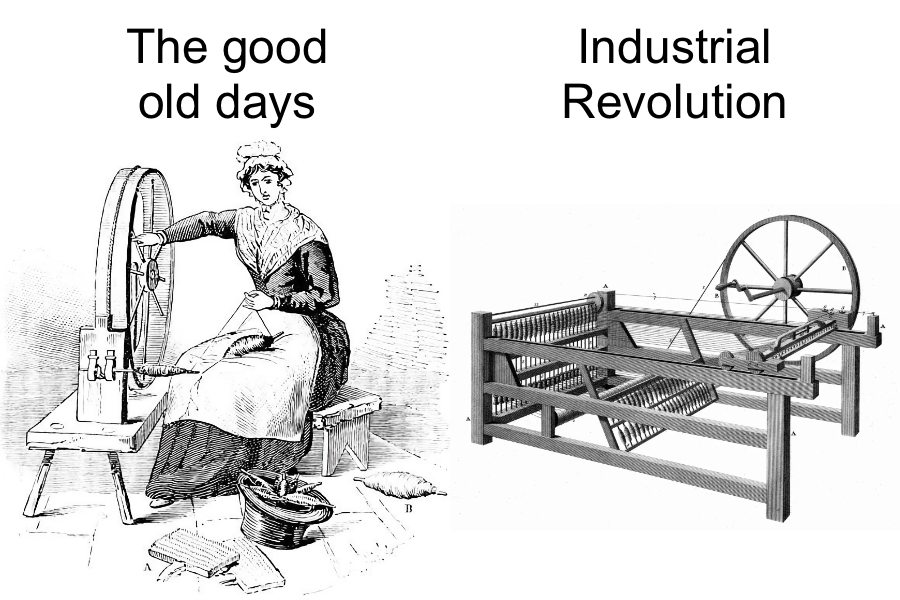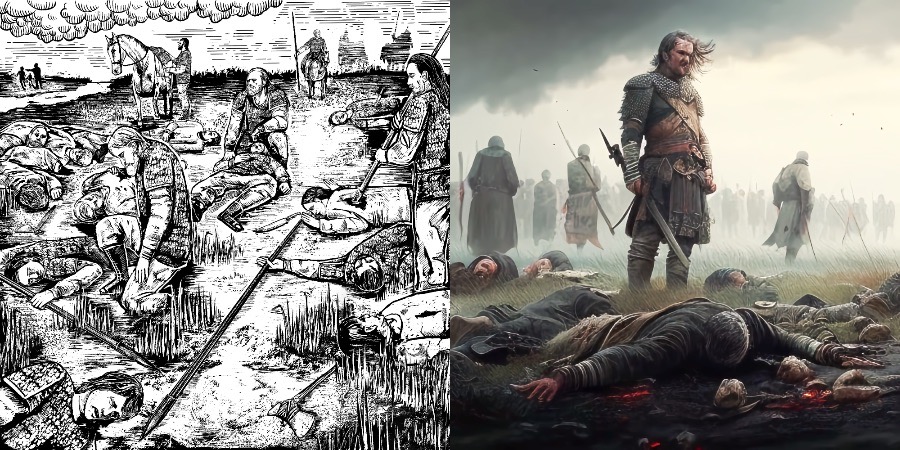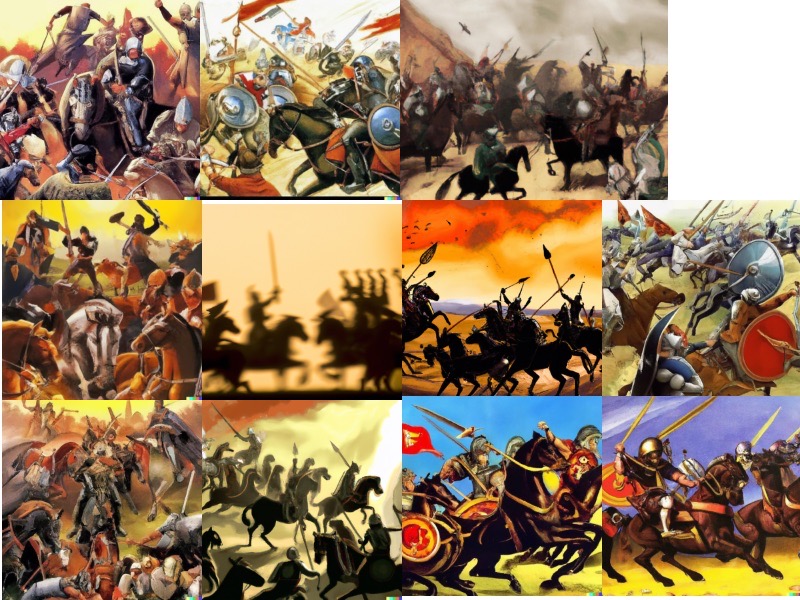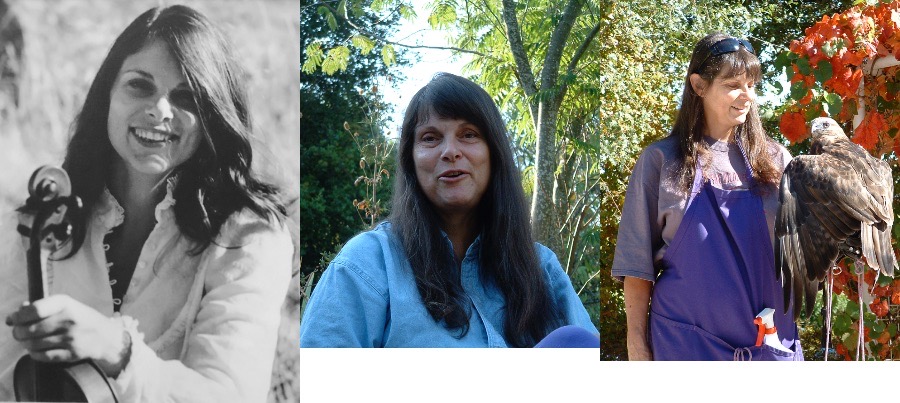April 14th, 2023
The release of Chat4-GPT last November has triggered an avalanche of commentary. Some of that commentary is effusively excited: “AI will trigger glorious revolutions!” Some of it is Cassandra-esque: “AI will trigger horrible revolutions!” What can we make of this?
I tend toward the more optimistic side of the spectrum. The history of technology abounds with cases in which a new technology was received with predictions of the horrors it would generate. Before the Scientific Revolution, almost any striking technological feat triggered accusations of satanic influence. Slow advances in existing technologies raised no concerns, but sudden discoveries were apt to get the discoverer in trouble.
With the Scientific Revolution, the notion of progress as a good thing, along with the reduction in the power of religious superstition, and in fact, people became enthusiastic about scientific discoveries, flocking to lectures explaining the latest scientific discoveries. A new line of opposition arose from laborers whose jobs were eliminated by technology. Here’s how the manufacture of textiles changed:

The “Spinning Jenny” on the right was one of the first machines of the Industrial Revolution, and it produced thread so cheaply that it put thousands of people out of work. They reacted by attacking and destroying the machines. The violence against industrialization peaked with Ned Ludd, the legendary leader of the people who destroyed machinery (who may have been entirely mythical).
What these people didn’t realize is that these same machines were making clothing vastly cheaper. Look at Mr. Ludd’s attire; it’s a hodgepodge of bits of cloth thrown together. Of course, it’s a caricature, but it does communicate the reality of clothing before the Industrial Revolution. People in those days had little in the way of clothing, usually torn and of poor quality. The same machines that put tens of thousands of people out of work made far superior clothing available to millions of people. Despite their fury, the Luddites failed to stop progress.
The last two hundred years have seen the continuation of this process: new technologies wipe out thousands of jobs, but dramatically reduce the price of the product to society. Because the overall process helps many more people than it hurts, society ignores the protests of the displaced workers and technology stomps right over them.
So the march of progress looks like a trade-off between the well-being of a minority of laborers and the well-being of the masses, with the masses always winning. But there’s another factor that few people notice: the advance in the quality of work. Consider the woman in the first illustration. She spent most of her life spinning thread, a tedious and mind-numbing task requiring nimble fingers and an easily stupified mind. That woman’s great-great-great granddaughter is now working as the HR director for small startup, using a much higher level of human talent and with vastly greater potential for advancement. Moreover, the descendant owns more clothing than the ancestor could have made in her entire life.
Sure, technology destroys old jobs — but it also creates new jobs. Sure, we threw huge numbers of people out of work making thread, but now we have vastly more people designing clothing, planning the logistics of getting the inputs to the clothing factory, hiring and training new people, figuring out how to market the new styles, organizing the distribution of the products, and on and on and on. What was once a small cottage industry is now a huge worldwide operation employing tens to hundreds of millions of people.
What does this have to do with AI?
These basic principles apply just as well to Large Language Model AI as they did to steam engines and Spinning Jennies. Yes, these AI systems will put some people out of work. My guess is that the most vulnerable have got to be the people who write stories about sports events. If I were to show you a newspaper report on a football game in 1973 (50 years ago) and a newspaper report on a football game in 2023, do you really think that you’d be able to tell which story comes from which year? Sports stories are pretty much the same year in and year out. We don’t need people to write them; we can easily train an AI system to grind out these stories for us. Poof! There went the jobs of sports writers all over the country.
Before you shed a tear for those unemployed sports writers, consider the likelihood that the better sports writers will find new work writing deeper stories about sports. They could interview athletes in greater depth and produce interesting profiles of their subjects. They could write analytical pieces on how the season is shaping up with the new balance of power between the teams. They’d be using their minds for something more than simply reciting the goals made, home runs hit, tackles made, controversial calls, and so on.
People build on top of new technology. It replaces old jobs, permitting people to work at higher levels that challenge their talents at a deeper level. One modern worker replaces an entire department of old-time workers who slaved away at tasks that the modern worker’s computer handles in a flash. AI will take over more and more of the drudge work, freeing people to do more interesting things.
Generative Imagery
The most intense controversy that I have seen so far concerns image generation systems such as DALL-E, Midjourney, and Stable Diffusion. Artists are reacting to these systems in much the same way that the Luddites reacted to textile machinery — except that they aren’t engaging in any destruction. Artists deem these things to be a threat to their livelihood. I don’t blame them; in fact, I agree that these technologies will replace a lot of the work now done by artists.
I truly sympathize with the artists on this. For the last six months, I have been engaging the services of “shecr0w”, a brilliant and highly creative artist in Brazil who creates beautiful illustrations for my storyworld, Le Morte D’Arthur. She doesn’t charge much for her work, either.
As an experiment, after shecr0w had created an image for me, I challenged Midjourney to produce its own image. The specification was for the aftermath of a battle in my Arthurian storyworld, a somber image with soldiers going over the battlefield, finishing off enemy wounded, succoring their own wounded, and grieving over their dead. Here are the results:

This comparison doesn’t quite do justice to shecr0w’s work, as it is a bit too compressed to show the fine detail. At first glance, the Midjourney version on the right looks better. After all, it’s in color and has higher resolution. However, it suffers from a number of flaws. The sword in the soldier’s hand has a bayonet where the hilt should be. The soldier’s clothing is all wrong for my Arthurian world. Shecr0w’s soldiers are correct in wearing scale armor and are armed primarily with spears. I prefer her illustration and it is the one I chose to use in the final product.
Nevertheless, the quality of the Midjourney image justifies the fear that these technologies will soon threaten the livelihoods of artists like shecr0w. I needed a great many battle images for Le Morte D’Arthur; here are some of the images from Midjourney that I used:

I also used DALL-E, whose results were nowhere near as good, but I accepted them because of their, ahem, “abstract quality”:

Yes, they stink, but I needed a LOT of images, and I didn’t have a lot of money. Maybe someday I’ll go back and get better images.
AI image generators perform poorly when their database of images relevant to the desired subject is skimpy. This was the problem that handicapped the creation of the battle images. There just aren’t that many images on the Internet of early sixth century Romano-British soldiers fighting Saxons. In fact, I don’t think that there are ANY such images, so I had to settle for “ancient Saxon warriors” for most of the imagery. Even then, I had to weed out lots of images derived from fantasy and videogame illustrations of burly warriors clad in armor teeming with horns and points.
On the other hand, AI generators do very well with portraits. I needed a great many portraits of Guenevere in a variety of different moods, and I needed them to be based on my photos of my first girlfriend, Gemma:

Here’s how Midjourney transformed Gemma into Guenevere:

As you can see, Midjourney did a great job with these images.
All in all, I used about 40 images from shecr0w, about 50 images from Midjourney, about 20 images from DALL-E, 40 images of my own creation, and about 25 images from other sources.
These results bode ill for artists. I relied on shecr0w for less than 25% of the images I needed. Even if you discount the images I created myself, she supplied only about 30% of my externally sourced images — and the AI image generators supplied HALF of those externally supplied images. My own experience was that the AI image generators played a larger role than the human artist. That’s not good!
So what are artists to do? Are they doomed to be replaced by AI image generators? There’s a fundamental injustice here, because the AI image generators are really just copying and remixing images previously created by human artists. Artists are quite justifiably angered to see their own work being used to put them out of work.
My first counsel to artists is that they not play the Luddite, not because it’s wrong, but because it’s futile. There is no means by which you can stop the progress of AI image generators. This technology is useful and it will expand and spread through society. There is no benefit in spitting into the wind.
Rather, I suggest that ju-jitsu is more promising that head-butting. Use the power of your adversary to your own benefit. Artists should master this technology and use it as the starting point of their work. Consider the crucial fact that every single one of the AI generated images suffered from some flaw. Even the very best of the lot (the images of Guenevere) fall short of my hopes. She wears different clothing in the pictures and different jewelry. Her hair styles are inconsistent and she is at different ages in different images. If you examine these portraits closely, you’ll see that they are not the same woman. An artist should be able to coax better images out of the AI, then modify them to achieve a better end result.
Let’s compare three people competing in creating images. The first is a conventional artist who creates an image from scratch using conventional digital tools. The second is a professional AI wrangler who creates carefully crafted prompt text to obtain the desired image. The third is a conventional artist who has master the craft of creating good prompts and uses that craft to quickly create a great initial image, then edits that initial image and adds touches using old tools.
Which of these three competitors do you think will be most successful?
A Fundamental Limitation of All AI
People think that someday AI systems will be smarter than humans. That has already happened: computers can calculate arithmetic far more quickly and accurately than humans. Computers can beat humans at chess and a variety of other games. It seems an obvious extrapolation that computers will someday be able to sing “Anything you can do, I can do better!”
Ain’t gonna happen. People just don’t grasp a simple fact:
Computers and humans are different.
Yes, friends, silicon and DNA operate in profoundly different ways. Yet many people believe that the two are functionally similar, and that someday we’ll be able to upload our brains into vast computer systems so as to live forever. What silly rubbish!
Sure, computers and brains both process information. That doesn’t mean that one can effectively emulate the other. Their methods of information processing are profoundly different. It’s not just that neurons differ from transistors. The specific and uncopyable difference is the complex chemical subtleties of brain function. Everything that is happening in your body influences your brain. When you sleep, your bodies chemical composition shifts in ways that affect your brain. When your muscles operate, they release a variety of chemicals that alter brain function. When you are hot or cold, that changes the biochemistry of your brain, too. And emotions — gee, emotions are crazy combinations of brain activity and hormones. A person who is angry, sad, or sexually aroused experiences dramatic changes in both body chemistry and brain function. It’s impossible to say whether the body is influencing the brain or vice versa, because in fact the causal forces run in both directions.
If you have any doubts about this process, I urge you to read Descartes’ Error: Emotion, Reason, and the Human Brain, by Antonio Damosio. This book, written by a neuroscientist, will forever disabuse you of any notion that the brain can be simulated by a computer — not until we build a computer that has all the biochemical complexity of the human body.
The End Game
Where will all this end? What will happen when all physical labor is done by robots, and all mental labor is done by AI? Will humanity obsolete itself?
Nope, because there are three tasks that AI can never effectively handle: artistic creation, teaching, and scientific discovery. The former is beyond the reach of computers because artistic creativity requires a deep understanding of the human condition. A computer can never appreciate the feeling of the spring sun on your face, or why many people eat ice cream when they’re feeling down, or the transcendant feeling of making love. Without truly experiencing profound human emotion, no computer can compete with human artistic creativity.
Teaching also lies beyond the reach of even the most powerful computer imaginable, because the computer cannot empathize with the student. That inability to empathize is, again, due to the inability of the computer to emulate the brain-body interactions. Computers can present information to students and can interact intellectually with students, but a computer will never be able to tease out the subtle sources of confusion or reluctance on the part of a student.
Scientific discovery will also be confined to humans. Yes, computers will carry out all the grunt work, performing observations, measurements, and statistical calculations. But the creation of hypotheses and the exercise of judgement regarding the merits of different hypotheses will forever remain outside of the realm of computation, because such tasks require the tight integration of the entire corpus of relevant information and a sense of intellectual elegance.
Accordingly, the equilibrium between computers and humans will be reached when computer produce all the material wealth, and people are all artists, educators, and scientists. That, I believe, will be a much better world.
Of course, we’ll never get there.
Post Scriptum
A reader notified me that another group of workers is threatened with loss of their livelihoods by AI: adult movie stars. It seems that some enterprising groups have assembled AI image generation engines specializing in the creation of pornographic imagery. I examined some of the sample images created by this technology, and noted two striking features of these images. While they certainly do a fine job generating images that are, in toto, quite pornographic, every one of the half-dozen images I saw placed the woman’s hands out of view. I laughed out loud when I realized that this must be due to the universal failure of these technologies to understand that humans have four fingers and a thumb. I suppose that a buxom beauty with three proper fingers in addition to three partly-formed ones just wouldn’t have that sex appeal the artist was striving for.
They’ll eventually figure out hacks to insure that people have the correct number of fingers and toes, but I noticed a more fundamental flaw. Our notions of beauty include many very specific expectations of bodily features, and I noticed that, while faces and breasts were always correct, sometimes other parts of the body were just a bit off. A few upper arms didn’t have the right convexity properly reflecting the biceps. One woman’s neck wasn’t quite symmetric, while another’s collarbone seemed a bit too prominent. The net effect was to rob the images of much of their sex appeal. I had not realized just how much our notions of female beauty rely on perfect proportions in EVERY aspect of female anatomy. We subconsciously notice even slight deviations from our expectations.
Hence, I think that adult movie stars have some time left before they are sent to the unemployment line by AI. I can’t help but wonder how they’ll explain their inability to find work to the bureaucrat reviewing their case.
